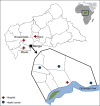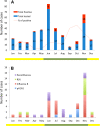First introduction of pandemic influenza A/H1N1 and detection of respiratory viruses in pediatric patients in Central African Republic
- PMID: 23391188
- PMCID: PMC3598402
- DOI: 10.1186/1743-422X-10-49
First introduction of pandemic influenza A/H1N1 and detection of respiratory viruses in pediatric patients in Central African Republic
Abstract
Background: Acute viral respiratory illnesses in children in sub-Saharan Africa have received relatively little attention, although they are much more frequent causes of morbidity and mortality than in developed countries. Active surveillance is essential to identify the causative agents and to improve clinical management, especially in the context of possible circulation of pandemic viruses.
Findings: A prospective study was conducted in the Central African Republic (CAR) between January and December 2010 among infants and children aged 0-15 years attending sentinel sites for influenza-like illness or acute respiratory illness. Nasopharyngeal swabs were collected, and one-step real-time and multiplex reverse transcription-polymerase chain reaction were used to detect respiratory viruses. Respiratory viruses were detected in 49 of the 329 (14.9%) nasopharyngeal samples: 29 (8.8%) contained influenza viruses (5 (1.5%) had pandemic influenza A/H1N1 virus and 24 (7.3%) had influenza B viruses), 11 (3.3%) contained parainfluenza viruses types 1 and 3 and 9 (2.7%) contained human respiratory syncytial virus. Most cases were detected during the rainy season in the CAR. Analysis of the amplicon sequences confirmed the identity of each detected virus.
Conclusions: The influenza surveillance system in the CAR has provided valuable data on the seasonality of influenza and the circulation of other respiratory viruses. Our network could therefore play a valuable role in the prevention and control of influenza epidemics in the CAR.
Figures


References
Publication types
MeSH terms
Associated data
- Actions
- Actions
- Actions
- Actions
- Actions
- Actions
- Actions
- Actions
- Actions
- Actions
- Actions
- Actions
- Actions
- Actions
LinkOut - more resources
Full Text Sources
Other Literature Sources
Medical

